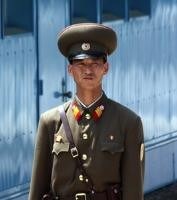On March 11, North Korea declared that it would withdraw from the 1953 armistice that stopped the war on the Korean Peninsula. In an email interview, Balbina Y. Hwang, a visiting professor at Georgetown University and a former adviser at the U.S. State Department who has written extensively on the Koreas, discussed the significance of the move and its likely impacts.
WPR: Technically, what does the armistice control?
Balbina Y. Hwang: The Korean Armistice, signed on July 27, 1953, established the parameters of a cease-fire between the official warring parties of the Korean conflict: the Democratic People’s Republic of Korea (DPRK) and the United Nations Command (UNC), the unified command structure for the multinational military forces led by the United States, supporting the Republic of Korea (ROK). The armistice establishes a military demarcation line between the two Koreas roughly following the 38th parallel, and a 2.5-mile-wide demilitarized buffer zone (DMZ) that ironically remains today one of the most heavily fortified borders in the world. It is critical to note that the agreement is a military one signed by the military commanders and not a political agreement among nations. This is significant because the ROK famously refused to sign the armistice at the time because it would not accept a division of the Korean Peninsula, and the document was endorsed by the military commander of the UNC representing 22 countries, including the U.S. and ROK, and by the DPRK military commander, who signed on behalf of North Korea and China’s Peoples’ Volunteer Army, which fought on the side of the DPRK. Because the armistice is a military cease-fire arrangement, it does not provide a resolution to the Korean War, nor does it contain any political arrangements for a permanent peace. Thus, the two Koreas are technically still in a state of war, and hostilities continue, but wide-scale military conflict has essentially been held at bay for 60 years due to this agreement.

